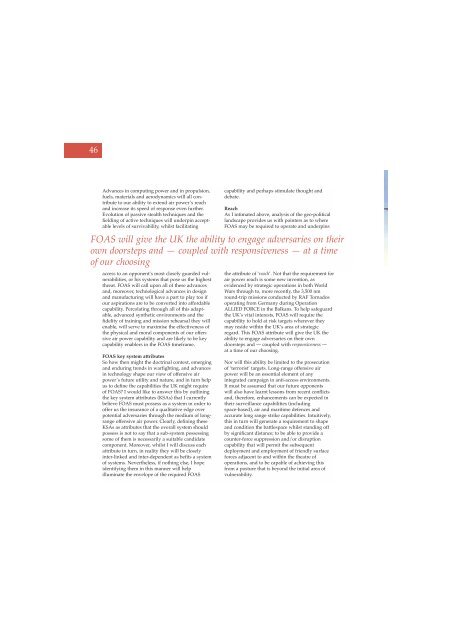Volume 6 No 4 - Royal Air Force Centre for Air Power Studies
Volume 6 No 4 - Royal Air Force Centre for Air Power Studies
Volume 6 No 4 - Royal Air Force Centre for Air Power Studies
Create successful ePaper yourself
Turn your PDF publications into a flip-book with our unique Google optimized e-Paper software.
46<br />
Advances in computing power and in propulsion,<br />
fuels, materials and aerodynamics will all contribute<br />
to our ability to extend air power’s reach<br />
and increase its speed of response even further.<br />
Evolution of passive stealth techniques and the<br />
fielding of active techniques will underpin acceptable<br />
levels of survivability, whilst facilitating<br />
access to an opponent’s most closely guarded vulnerabilities,<br />
or his systems that pose us the highest<br />
threat. FOAS will call upon all of these advances<br />
and, moreover, technological advances in design<br />
and manufacturing will have a part to play too if<br />
our aspirations are to be converted into af<strong>for</strong>dable<br />
capability. Percolating through all of this adaptable,<br />
advanced synthetic environments and the<br />
fidelity of training and mission rehearsal they will<br />
enable, will serve to maximise the effectiveness of<br />
the physical and moral components of our offensive<br />
air power capability and are likely to be key<br />
capability enablers in the FOAS timeframe.<br />
FOAS key system attributes<br />
So how then might the doctrinal context, emerging<br />
and enduring trends in warfighting, and advances<br />
in technology shape our view of offensive air<br />
power’s future utility and nature, and in turn help<br />
us to define the capabilities the UK might require<br />
of FOAS? I would like to answer this by outlining<br />
the key system attributes (KSAs) that I currently<br />
believe FOAS must possess as a system in order to<br />
offer us the insurance of a qualitative edge over<br />
potential adversaries through the medium of longrange<br />
offensive air power. Clearly, defining these<br />
KSAs as attributes that the overall system should<br />
possess is not to say that a sub-system possessing<br />
some of them is necessarily a suitable candidate<br />
component. Moreover, whilst I will discuss each<br />
attribute in turn, in reality they will be closely<br />
inter-linked and inter-dependent as befits a system<br />
of systems. Nevertheless, if nothing else, I hope<br />
identifying them in this manner will help<br />
illuminate the envelope of the required FOAS<br />
capability and perhaps stimulate thought and<br />
debate.<br />
Reach<br />
As I intimated above, analysis of the geo-political<br />
landscape provides us with pointers as to where<br />
FOAS may be required to operate and underpins<br />
FOAS will give the UK the ability to engage adversaries on their<br />
own doorsteps and — coupled with responsiveness — at a time<br />
of our choosing<br />
the attribute of ‘reach’. <strong>No</strong>t that the requirement <strong>for</strong><br />
air power reach is some new invention, as<br />
evidenced by strategic operations in both World<br />
Wars through to, more recently, the 3,500 nm<br />
round-trip missions conducted by RAF Tornados<br />
operating from Germany during Operation<br />
ALLIED FORCE in the Balkans. To help safeguard<br />
the UK’s vital interests, FOAS will require the<br />
capability to hold at risk targets wherever they<br />
may reside within the UK’s area of strategic<br />
regard. This FOAS attribute will give the UK the<br />
ability to engage adversaries on their own<br />
doorsteps and — coupled with responsiveness —<br />
at a time of our choosing.<br />
<strong>No</strong>r will this ability be limited to the prosecution<br />
of ‘terrorist’ targets. Long-range offensive air<br />
power will be an essential element of any<br />
integrated campaign in anti-access environments.<br />
It must be assumed that our future opponents<br />
will also have learnt lessons from recent conflicts<br />
and, there<strong>for</strong>e, enhancements can be expected in<br />
their surveillance capabilities (including<br />
space-based), air and maritime defences and<br />
accurate long range strike capabilities. Intuitively,<br />
this in turn will generate a requirement to shape<br />
and condition the battlespace whilst standing off<br />
by significant distance; to be able to provide a<br />
counter-<strong>for</strong>ce suppression and/or disruption<br />
capability that will permit the subsequent<br />
deployment and employment of friendly surface<br />
<strong>for</strong>ces adjacent to and within the theatre of<br />
operations, and to be capable of achieving this<br />
from a posture that is beyond the initial area of<br />
vulnerability.
















